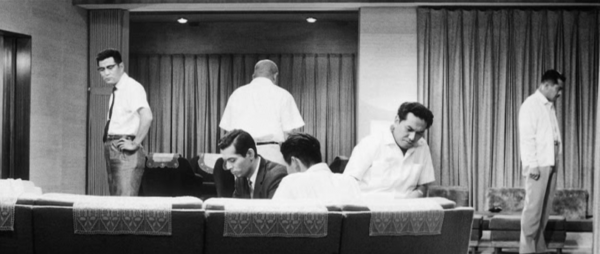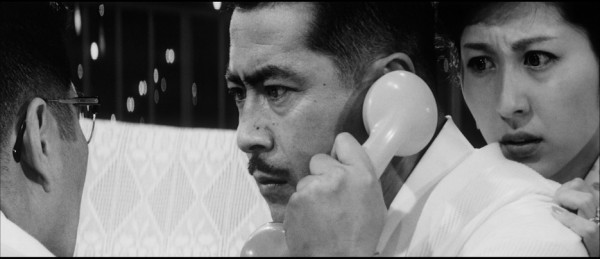HIGH AND LOW (TENGOKU TO JIGOKU) (Akira Kurosawa, 1963)
Museum of the Moving Image
35th Ave. at 36th St., Astoria
Saturday, March 7, $12, 4:30
Series runs March 6-13
718-777-6800
www.movingimage.us
www.reverseshot.org
 On the verge of being forced out of the company he has dedicated his life to, National Shoes executive Kingo Gondo’s (Toshirō Mifune) life is thrown into further disarray when kidnappers claim to have taken his son, Jun (Toshio Egi), and are demanding a huge ransom for his safe return. But when Gondo discovers that they have mistakenly grabbed Shinichi (Masahiko Shimazu), the son of his chauffeur, Aoki (Yutaka Sada), he at first refuses to pay. But at the insistence of his wife (Kyogo Kagawa), the begging of Aoki, and the advice of police inspector Taguchi (Kenjiro Ishiyama), he reconsiders his decision, setting in motion a riveting police procedural that is filled with tense emotion. Loosely based on Ed McBain’s 87th Precinct novel King’s Ransom, Akira Kurosawa’s High and Low, photographed by longtime Kurosawa cinematographer Asakazu Nakai, is divided into two primary sections: The first half takes place in Gondo’s luxury home, orchestrated like a stage play as the characters are developed and the plan takes hold. The second part of the film follows the police, under the leadership of Chief Detective Tokura (Tatsuya Nakadai), as they hit the streets of the seedier side of Yokohama in search of the kidnappers. Known in Japan as Tengoku to Jigoku, which translates as Heaven and Hell, High and Low is an expert noir, a subtle masterpiece that tackles numerous socioeconomic and cultural issues as Gondo weighs the fate of his business against the fate of a small child; it all manages to feel as fresh and relevant today as it probably did back in the ’60s.
On the verge of being forced out of the company he has dedicated his life to, National Shoes executive Kingo Gondo’s (Toshirō Mifune) life is thrown into further disarray when kidnappers claim to have taken his son, Jun (Toshio Egi), and are demanding a huge ransom for his safe return. But when Gondo discovers that they have mistakenly grabbed Shinichi (Masahiko Shimazu), the son of his chauffeur, Aoki (Yutaka Sada), he at first refuses to pay. But at the insistence of his wife (Kyogo Kagawa), the begging of Aoki, and the advice of police inspector Taguchi (Kenjiro Ishiyama), he reconsiders his decision, setting in motion a riveting police procedural that is filled with tense emotion. Loosely based on Ed McBain’s 87th Precinct novel King’s Ransom, Akira Kurosawa’s High and Low, photographed by longtime Kurosawa cinematographer Asakazu Nakai, is divided into two primary sections: The first half takes place in Gondo’s luxury home, orchestrated like a stage play as the characters are developed and the plan takes hold. The second part of the film follows the police, under the leadership of Chief Detective Tokura (Tatsuya Nakadai), as they hit the streets of the seedier side of Yokohama in search of the kidnappers. Known in Japan as Tengoku to Jigoku, which translates as Heaven and Hell, High and Low is an expert noir, a subtle masterpiece that tackles numerous socioeconomic and cultural issues as Gondo weighs the fate of his business against the fate of a small child; it all manages to feel as fresh and relevant today as it probably did back in the ’60s.
High and Low is screening March 7 at 4:30 as part of the Museum of the Moving Image series “See It Big! High and Wide,” which runs March 6-13 in conjunction with the Reverse Shot online symposium “Take Five: Reverse Shot in Space.” “High and Low is a particularly emphatic example of Kurosawa’s attention to spatial continuity over the course of an entire film,” Ben Parker writes on Reverse Shot. “The title announces one spatial organization, the vertical juxtaposition of prosperous legality — symbolized by the hilltop estate of shoe executive Kingo Gondo — and the miasmic squalor and slinking resentment of the urban lower depths. But the very look of the film tells a different story. High and Low was shot using the TohoScope process, drastically widening the frame for an aspect ratio of 2.35:1. However much the social and moral themes of the film are posed along the vertical axis . . . the images and compositions are constrained to the horizontal. Ultimately, Kurosawa is attempting to undo the vertical binary of postwar Japanese society. This ‘leveling,’ however, is not as simple as filming in wide screen. Rather, the visual theme of the film culminates in its hard-won conclusion. In the last scene, Kurosawa arrives at a very different leveling of social space than that imagined by the diseased resentment of his villain.” The eight-day festival also includes such films as Jacques Tati’s Playtime, Michael Powell and Emeric Pressburger’s A Matter of Life and Death, George Stevens’s Shane, and Elem Klimo’s Come and See.

